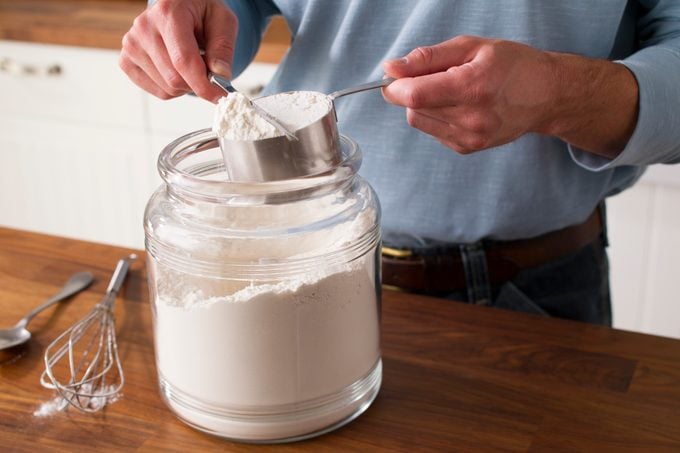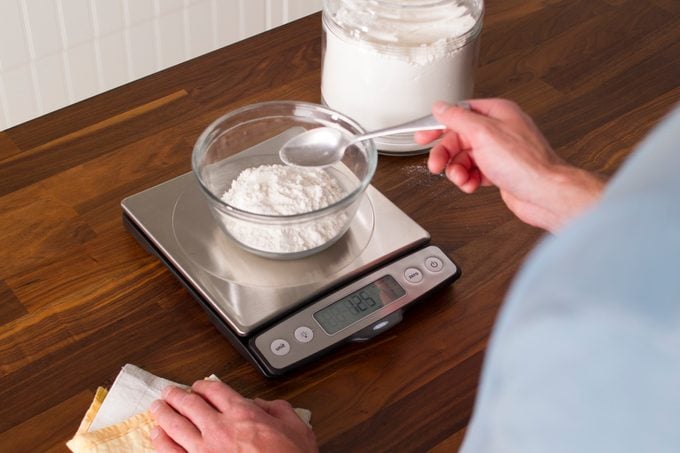Baking is a science! Too much or too little flour can totally alter a recipe. Our Test Kitchen shows you how to measure flour correctly so you'll get your best-ever bakes.
How to Measure Flour Correctly
All good bakers know their craft is just as much science as it is art. And any good science experiment requires precision for the best results. With baking, that means getting the right times, temperatures and—perhaps most importantly—measurements. Knowing how to measure ingredients can be tricky, though, especially with finer ingredients like flour.
To illustrate how easy it is to make a measuring mistake, we devised an impromptu test. Our Test Kitchen pros asked other Taste of Home staffers to measure flour as they would at home, and the results were staggering. Some measured cups of flour as light as 3 ounces and some as heavy as 5-1/2 ounces. In short, a far cry from the correct weight of a cup of flour: 4-1/4 ounces. That extra ounce or two can turn chocolate chip cookies into hockey pucks. Yikes!
To make sure you don’t run into problems the next time you’re craving a cookie, our Test Kitchen prepared a short refresher on how to measure flour for perfect cookies (and cakes and brownies) every time.
Tools You’ll Need
- Use a kitchen scale to get the most precise measurement for any ingredient. Here’s more on why you need a kitchen scale.
- A good set of measuring cups is essential for any baker, especially if you’re measuring flour by volume.
- Keep a straight-edge tool in your flour container to make leveling off your measuring cup easy.
How to Measure Flour by Volume
For most home bakers, measuring by volume with a measuring cup is standard practice. But there are some secrets to getting a more accurate measurement with this basic tool. As a rule, flour should not be compacted when being measured—you’ll end up with far too much of the ingredient.
Here’s how to properly measure flour by volume:
Step 1: Fluff up the flour
Flour settles in storage, so it needs to be loosened with a spoon or whisk. Aerating the flour helps prevent overmeasuring.
Step 2: Fill the measuring cup

Next, spoon the flour into a measuring cup until heaping (piled beyond the rim of the measuring cup). Never scoop the flour with the measuring cup.
Step 3: Level off the flour
Finally, level the flour with the flat side of a knife. This should give you about 125 grams (4-1/4 ounces) of flour—a standard cup.
How to Measure Flour by Weight

For the most precise measurement, our Test Kitchen recommends measuring without measuring cups. In other words: Use a kitchen scale. To measure flour (or any ingredient), place a bowl on the scale, tare to zero and then add your flour.
How many grams in a cup of flour?
| FLOUR (In Cups) | –1/4– | –1/3– | –1/2– | –2/3– | –3/4– | –1– |
|---|---|---|---|---|---|---|
| All-Purpose | 30 | 40 | 60 | 80 | 90 | 120 |
| Cake | 29.5 | 39.3 | 59 | 78.6 | 88.5 | 118 |
| Self-Rising | 31 | 41.3 | 62 | 82.6 | 93 | 124 |
| Whole Wheat | 32.5 | 43.3 | 65 | 88.6 | 97.5 | 130 |
| All weights are in grams. | ||||||
Tips for Measuring Flour
Here are our top tips for how to properly measure flour:
- Never sift your flour before measuring unless your recipe specifically says to. Doing so will result in a lot less flour than the recipe calls for.
- Before measuring, fluff up the flour in the container by stirring with a spoon or whisk.
- Don’t use your measuring cup to scoop the flour. Spoon it into the measuring cup for better accuracy.
- There’s a right way to measure wet and dry ingredients, so make sure you’re using a measuring cup that’s made for dry ingredients. A coffee mug, rice measuring cup or a measuring cup for wet ingredients won’t give you the correct result!
- Don’t pack the flour down with the spoon as you’re scooping. Compressing the flour will give you an inaccurate result.























